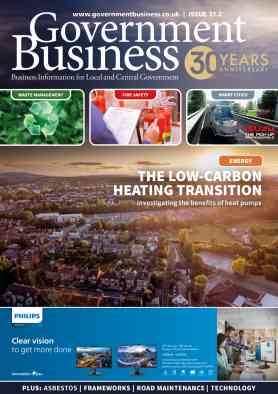Sue Robb of 4Children talks to Julie Laughton and Alison Britton from the Department for Education about the role of childminders in delivering the 30 hours free entitlement.
Rethinking council asset management
 The issue of how publicly owned property portfolios should be managed has come under the spotlight, with a recent report from the Audit Commission questioning whether current practices succeed in making the most of what in many instances is a highly valuable asset. Worth an estimated £169.8 billion in 2012/13, the local government estate is divided into two chief categories – ‘operational’, or those buildings that are used to house key public services like education and social care, and ‘non-operational’ buildings including investment properties and properties up for sale.
The issue of how publicly owned property portfolios should be managed has come under the spotlight, with a recent report from the Audit Commission questioning whether current practices succeed in making the most of what in many instances is a highly valuable asset. Worth an estimated £169.8 billion in 2012/13, the local government estate is divided into two chief categories – ‘operational’, or those buildings that are used to house key public services like education and social care, and ‘non-operational’ buildings including investment properties and properties up for sale.
The Audit Commission’s June report, titled Managing Council Property Assets: Using Data from the VFM Profiles, lists a number of criteria for how Government should handle these assets, falling under two main questions: ‘Are they using space efficiently?’ and ‘is there scope to release value from the estate?’ With assets designated as ‘surplus’ (meaning that they are not used for services or as an investment opportunity, and that there are no plans to sell the assets off) worth around £2.5 billion in total during the period examined in the report, councils could be sitting on a gold mine, the authors suggest. This is especially significant considering the current spending climate in the public sector.
Strategic Resources
The Commission’s best practice guidelines include: treating land and buildings as strategic resources that can assist in delivering key objectives; selling or transferring property that is no longer needed; making buildings more efficient; and considering flexible working, digital service provision and sharing buildings between more than one organisation when deciding how space in publicly owned property is to be allotted. Councils are also advised to “maximise income” arising from investment properties and to rent out space in operational buildings that is not currently in use. Moreover, these targets should be met without impacting on the normal provision of Local Authority services.
Audit Commission chairman Jeremy Newman comments on the advice published in the report: “To be clear, we are neither advocating that local government starts a wholesale sell-off of their land and property nor are we suggesting councils shouldn’t spend money on buying assets or on investment to improve their existing property. What we are highlighting is a group of assets that do not provide immediate benefit to local communities, but still require councils to spend money on maintaining them. These assets have potential value for councils.
“While not all such land or buildings may be sellable, councils should consider how much value they gain from surplus assets and how this could be increased. I urge councils to use the data held in the Commission’s ‘Value for Money (VFM) Profiles Tool’, such as spending on and value of land and property assets and ‘surplus’ assets, alongside their unique and detailed local knowledge, to regularly review if their estate is fit-for-purpose.”
Councils have a number of options when considering how they can achieve maximum return on land and property investments. One possible route is to enter into a public-private partnership, for example a Local Asset Backed Vehicle (LABV).
Under this model a corporate entity is created with ownership shared between a public sector body and a private sector partner. The state transfers land or buildings to the new entity, while the partner matches the value of these assets with cash. Proponents of this model claim that the private investment it brings to an area aids regeneration projects in blighted neighbourhoods. There have also been cases of councils collaborating successfully without any private sector involvement.
Reducing property expenditure
One motivating factor behind calls to review our approach to public sector property is cost reduction. The ‘Managing Council Property Assets’ report notes that in 2012/13 £5.6 billion went on premises-related expenditure, much of this sum spent on old buildings that require ongoing intensive maintenance work.
The Government Property Unit (GPU) aims to face this issue by ‘rationalising’ the Government estate, or reducing the number of properties it contains. The Ministry of Justice offers an example of this policy at work. The GPU has since 2010 been working to reduce the size of the Ministry’s estate by 50 per cent and make an expected saving of £47 million by 2014/15 through an “aggressive approach to the disposal of leases and freehold property” as well as through ‘flexible desking’.
This example from central government could serve as an example for local councils required to make savings and identify sources of income. Whatever approach is taken, many working with the public sector estate are beginning to see that a careful examination of current policies can bring. As the Audit Commission’s Jeremy Newman concludes: “Ultimately, councils know their population and their associated needs. They require the freedom to choose the approach to managing these assets that best suits their needs.”
Company Focus
Located in Bromley, Japanese Knotweed Eradication Ltd has been providing solutions in the treatment and removal of Japanese Knotweed (Fallopia Japonica) for over a decade. During this time we have mastered a repertoire of methods, from herbicidal treatments to landscaping solutions, tailored to address the unique challenges our clients face with this pervasive weed.
Event Diary
UKREiiF has quickly become a must-attend in the industry calendar for Government departments and local authorities.
The multi-award-winning UK Construction Week (UKCW), is the UK’s biggest trade event for the built environment that connects the whole supply chain to be the catalyst for growth and positive change in the industry.
Supplier Profiles
Geo Energy
At GeoEnergy Design, we're on a mission to disrupt the traditional way heating and cooling ha
Latest Features
Professor Harith Alani, director of the Knowledge Management Institute at the Open University explains how AI can be used for good and bad.
Alex Lawrence, head of health & social care, techUK sets out techUK’s Five Point Plan for CareTech.












